Experimental Investigation of Special-Shaped Concrete-Filled Square Steel Tube Composite Columns with Steel Hoops under Axial Loads
Abstract
:1. Introduction
2. Experimental Program
2.1. Specimen Design and Processing
2.2. Material Properties
2.2.1. Steel
2.2.2. Concrete
2.3. Test Device and Measurement Scheme
3. Test Results and Analyses
3.1. Test Phenomena and Failure Modes
3.2. Carrying Capacity
3.3. Load-Longitudinal Displacement Curves
3.4. Load–Strain Curves
3.5. Poisson’s Ratio for Steel Tubes
3.6. Bearing Mechanism
4. Finite Element Models
4.1. Stress–Strain Relationships for Steel
4.2. Element Type, Interaction, and Boundary Conditions
4.3. Stress–Strain Relationships for Confined Concrete
- CFST columns can be regarded as stirrups with zero longitudinal spacing between stirrups; consequently, its lateral effective restraint coefficient ke2 was taken as 1;
- The effective lateral restraint coefficient was calculated using the ratio of the concrete volume in the effectively confined area to the total concrete volume;
- The longitudinal deformation of the core and limb columns was coordinated under axial compression loading;
- The dividing line between the effectively and ineffectively confined zones of concrete in the cross-section of the square steel tube was assumed to be a parabola with a starting angle θ of 45° [23].
5. Verification
5.1. Failure Mode Comparison
5.2. Load–Strain Curves Comparison
5.3. Carrying Capacity Comparison
6. Conclusions
- The strength damage was dominated by the hoop-type specimen and the weld-type stub column. The damage mode of weld-type slender columns was dominated by bending instability damage.
- The carrying capacity of specimens HL-1 and WL-1 increased by 16.8% and 17.0%, respectively, compared with HL-2 and WL-2. However, the peak loads of specimens WT-1 decreased by 12.29% compared with WT-2. Thus, the bearing capacities of SS-CFSST columns were directly proportional to the steel tube’s thickness and inversely proportional to the slenderness ratios of the specimen.
- The peak loads of specimens HL-1, HT-1, and HL-2 increased by 19.86%, 20.86%, and 20.00% compared with WL-1, WT-1, and WL-2, respectively. The steel hoops can not only be regarded as a connection of square steel tubes but also delays the buckling of the steel tubes and improve the carrying capacity of the specimen.
- The average value of the ratio between the carrying capacity obtained from the FEM using the proposed constitutive relationship of confined concrete and the tested values is 1.01, with a standard deviation of 0.069. The finite element model established in this paper can be used to simulate the mechanical properties of SS-CFSST columns under axial compression.
Author Contributions
Funding
Institutional Review Board Statement
Informed Consent Statement
Data Availability Statement
Conflicts of Interest
References
- Alatshan, F.; Osman, S.A.; Hamid, R.; Mashiri, F. Stiffened Concrete-Filled Steel Tubes: A Systematic Review. Thin-Walled Struct. 2020, 148, 106590. [Google Scholar] [CrossRef]
- Nguyen, T.-T.; Thai, H.-T.; Ngo, T.; Uy, B.; Li, D. Behaviour and Design of High Strength CFST Columns with Slender Sections. J. Constr. Steel Res. 2021, 182, 106645. [Google Scholar] [CrossRef]
- Han, L.-H. Developments and Advanced Applications of Concrete-Filled Steel Tubular (CFST) Structures: Members. J. Constr. Steel Res. 2014, 100, 211–228. [Google Scholar] [CrossRef]
- Uy, B. Local and Post-Local Buckling of Concrete Filled Steel Welded Box Columns. J. Constr. Steel Res. 1998, 47, 47–72. [Google Scholar] [CrossRef]
- Uy, B. Strength of Short Concrete Filled High Strength Steel Box Columns. J. Constr. Steel Res. 2001, 57, 113–134. [Google Scholar] [CrossRef]
- Chen, Z.Y.; Shen, Z.Y. Behavior of L-Shaped Concrete-Filled Steel Stub Columns under Axial Loading: Experiment. Adv. Steel Constr. 2010, 6, 688–697. [Google Scholar] [CrossRef]
- Shen, Z.-Y.; Lei, M.; Li, Y.-Q.; Lin, Z.-Y.; Luo, J.-H. Experimental Study on Seismic Behavior of Concrete-Filled L-Shaped Steel Tube Columns. Adv. Struct. Eng. 2013, 16, 1235–1247. [Google Scholar] [CrossRef]
- Zuo, Z.-L.; Cai, J.; Chen, Q.-J.; Liu, X.-P.; Yang, C.; Mo, T.-W. Performance of T-Shaped CFST Stub Columns with Binding Bars under Axial Compression. Thin-Walled Struct. 2018, 129, 183–196. [Google Scholar] [CrossRef]
- Yang, Y.; Han, X.; Nan, B.; Tang, X. Research on Carrying Capacity of T-Shaped Stiffened Concrete-Filled Steel Tubular Columns Subjected to Eccentrically Compressive Load. Adv. Civ. Eng. 2021, 2021, 8867185. [Google Scholar] [CrossRef]
- Song, H.; Liu, J.; Yang, Y.; Chen, Y.F. Study on Mechanical Behavior of Integrated Multi-Cell Concrete-Filled Steel Tubular Stub Columns under Concentric Compression. Int. J. Civ. Eng. 2019, 17, 361–376. [Google Scholar] [CrossRef]
- Sui, Y.; Tu, Y.; Guo, Q.; Zhang, J.; Ke, F. Study on the Behavior of Multi-Cell Composite T-Shaped Concrete-Filled Steel Tubular Columns Subjected to Compression under Biaxial Eccentricity. J. Constr. Steel Res. 2019, 159, 215–230. [Google Scholar] [CrossRef]
- Cui, W.; Wang, L.; Chen, H.; Chen, H.; Liu, S. The Analysis on the Seismic Behavior of T-Shaped Prefabricated Special-Shaped CFST with Rectangular Multi-Cell Columns. Structures 2020, 28, 803–815. [Google Scholar] [CrossRef]
- Sun, H.; Xu, Q.; Yan, P.; Yin, J.; Lou, P. A Study on Axial Compression Performance of Concrete-Filled Steel-Tubular Shear Wall with A Multi-Cavity T-Shaped Cross-Section. Energies 2020, 13, 4831. [Google Scholar] [CrossRef]
- Wang, Z.; Zhou, X.; Wei, F.; Li, M. Performance of Special-Shaped Concrete-Filled Square Steel Tube Column under Axial Compression. Adv. Civ. Eng. 2020, 2020, 1763142. [Google Scholar] [CrossRef]
- Ouyang, Y.; Kwan, A.K.H. Finite Element Analysis of Square Concrete-Filled Steel Tube (CFST) Columns under Axial Compressive Load. Eng. Struct. 2018, 156, 443–459. [Google Scholar] [CrossRef]
- Grzeszykowski, B.; Szmigiera, E.D. Experimental Investigation on the Vertical Ductility of Rectangular CFST Columns Loaded Axially. Materials 2022, 15, 2231. [Google Scholar] [CrossRef]
- Hilo, S.J.; Sabih, S.M.; Abdulrazzaq, M.M. Numerical Analysis on the Behavior of Polygonal CFST Composite Columns under Axial Loading Using Finite Element. J. Eng. Sci. Technol. 2021, 16, 4975–4999. [Google Scholar]
- Alatshan, F.; Osman, S.A.; Mashiri, F.; Hamid, R. Explicit Simulation of Circular CFST Stub Columns with External Steel Confinement under Axial Compression. Materials 2019, 13, 23. [Google Scholar] [CrossRef] [Green Version]
- Rabbat, B.G.; Russell, H.G. Friction Coefficient of Steel on Concrete or Grout. J. Struct. Eng. 1985, 111, 505–515. [Google Scholar] [CrossRef]
- Manikandan, K.B.; Umarani, C. Parametric Study of CFST Columns by Numerical Mock-Up. Mater. Today Proc. 2021, 45, 6021–6027. [Google Scholar] [CrossRef]
- Rozylo, P. Stability and Failure of Compressed Thin-walled Composite Columns Using Experimental Tests and Advanced Numerical Damage Models. Int. J. Numer. Methods Eng. 2021, 122, 5076–5099. [Google Scholar] [CrossRef]
- Susantha, K.A.S.; Ge, H.; Usami, T. Uniaxial Stress–Strain Relationship of Concrete Confined by Various Shaped Steel Tubes. Eng. Struct. 2001, 23, 1331–1347. [Google Scholar] [CrossRef]
- Sheikh, S.A.; Uzumeri, S.M. Analytical Model for Concrete Confinement in Tied Columns. J. Struct. Div. 1982, 108, 2703–2722. [Google Scholar] [CrossRef]
- Mander, J.B.; Priestley, M.J.N.; Park, R. Theoretical Stress-Strain Model for Confined Concrete. J. Struct. Eng. 1988, 114, 1804–1826. [Google Scholar] [CrossRef] [Green Version]
- Han, L.-H.; Yao, G.-H.; Tao, Z. Performance of Concrete-Filled Thin-Walled Steel Tubes under Pure Torsion. Thin-Walled Struct. 2007, 45, 24–36. [Google Scholar] [CrossRef]
- Ding, F. Elasto-Plastic Analysis of Circular Concrete-Filled Steel Tube Stub Columns. J. Constr. Steel Res. 2011, 67, 1567–1577. [Google Scholar] [CrossRef]
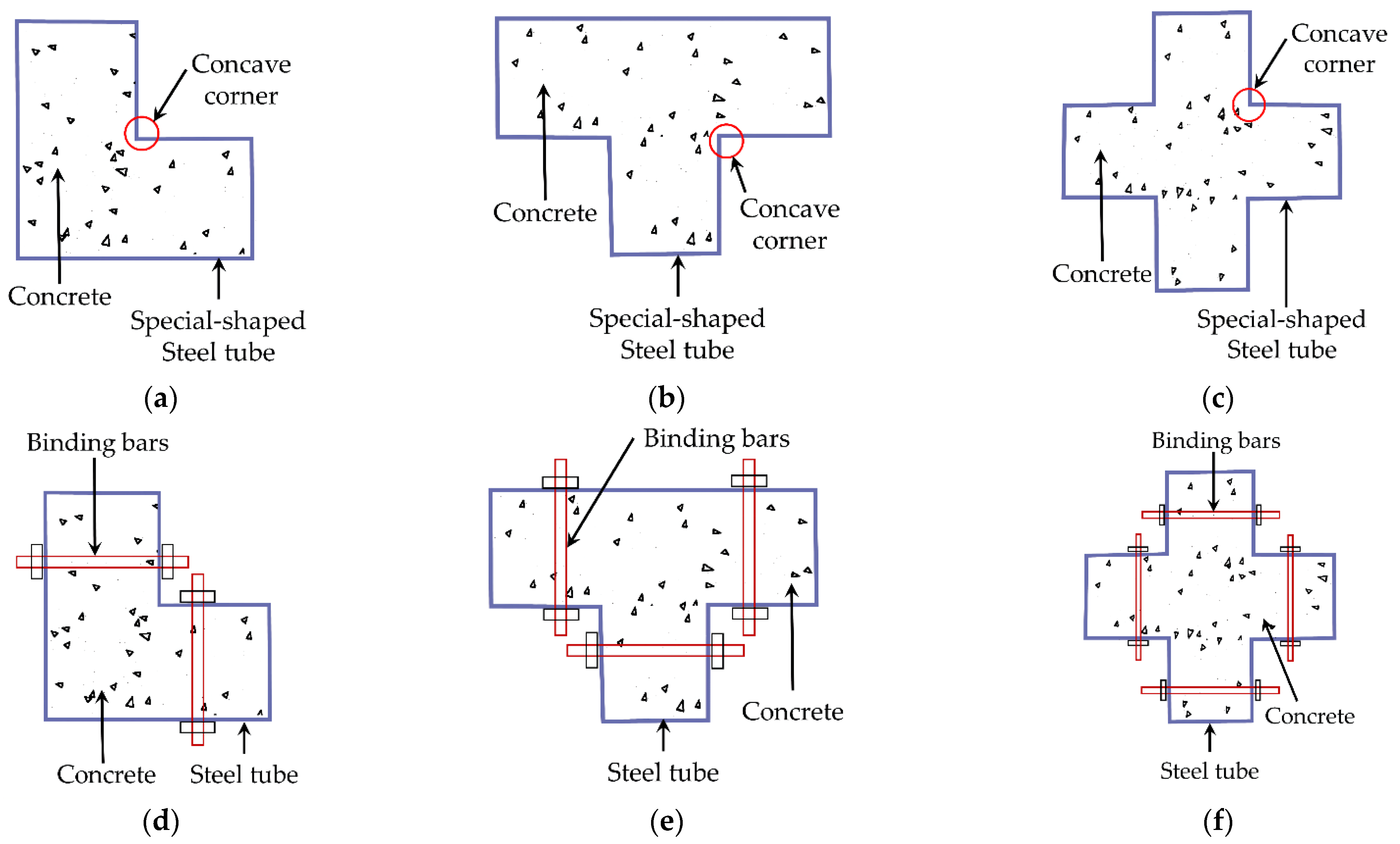





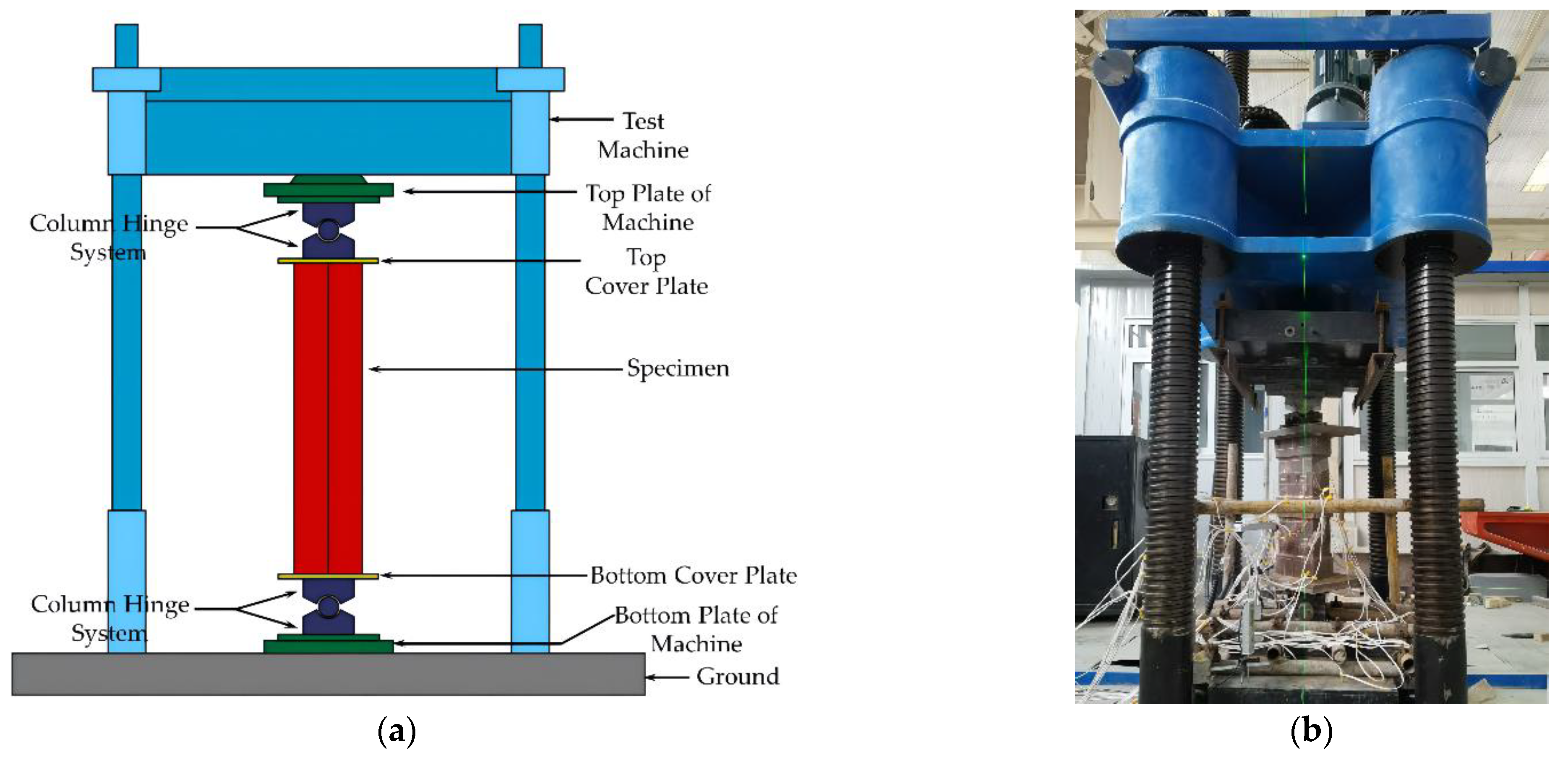
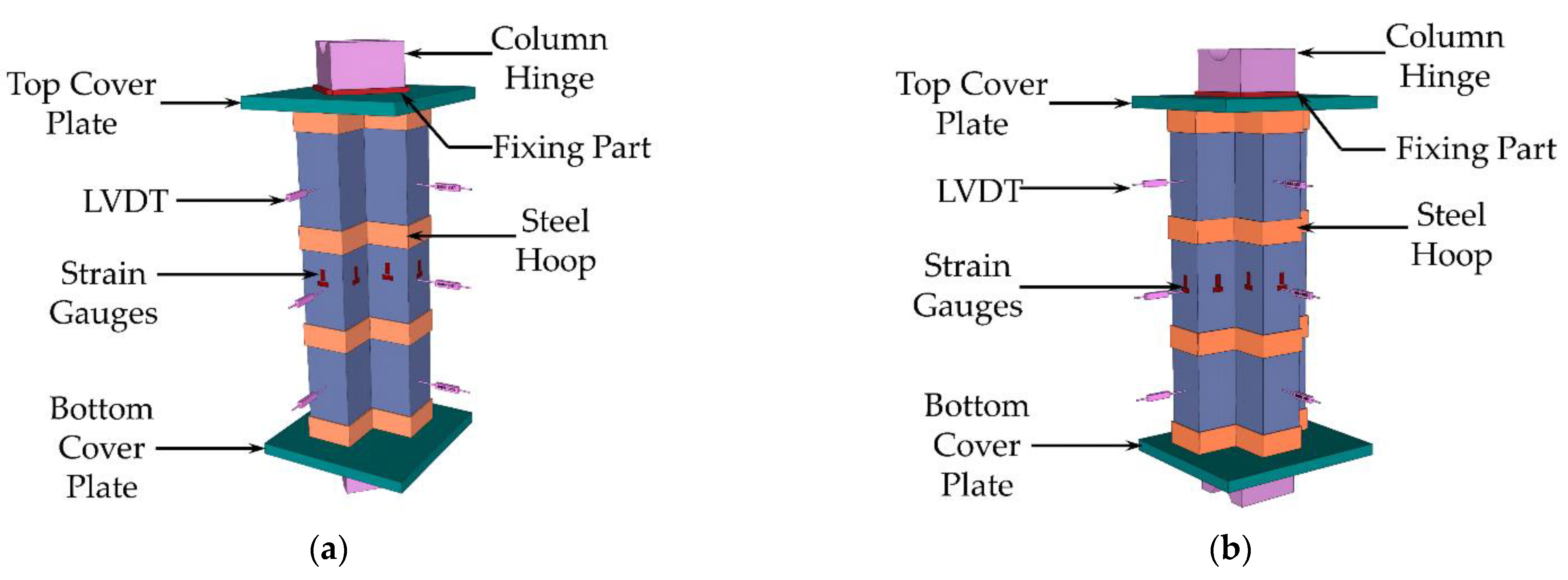
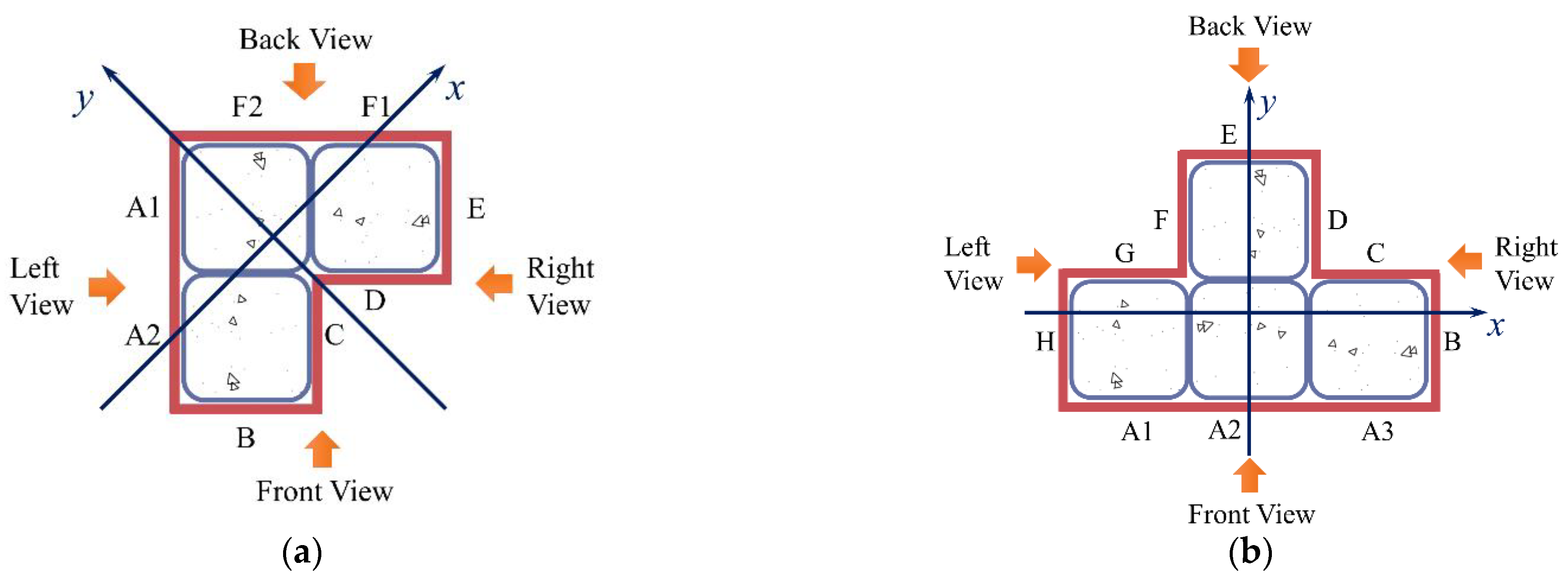


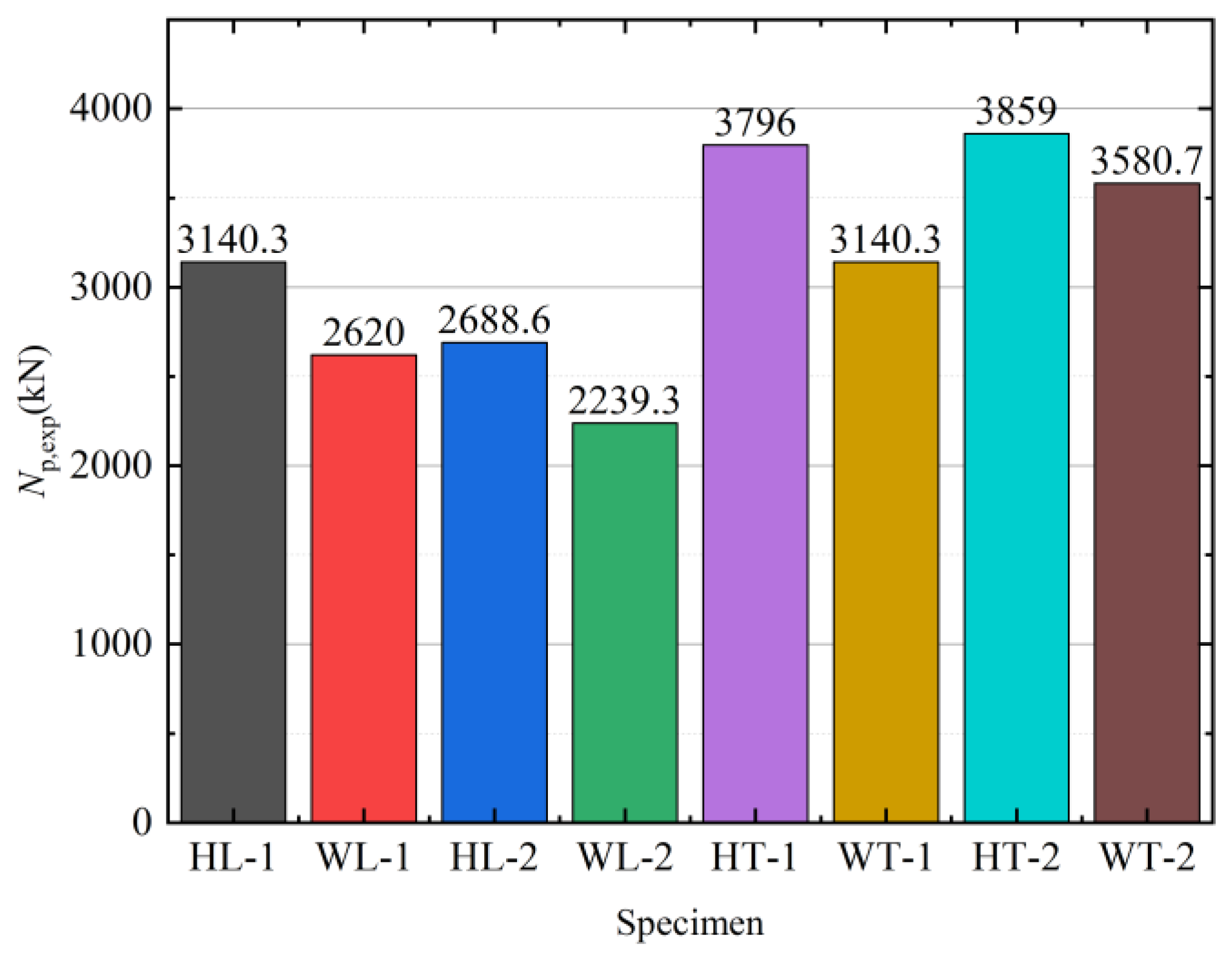

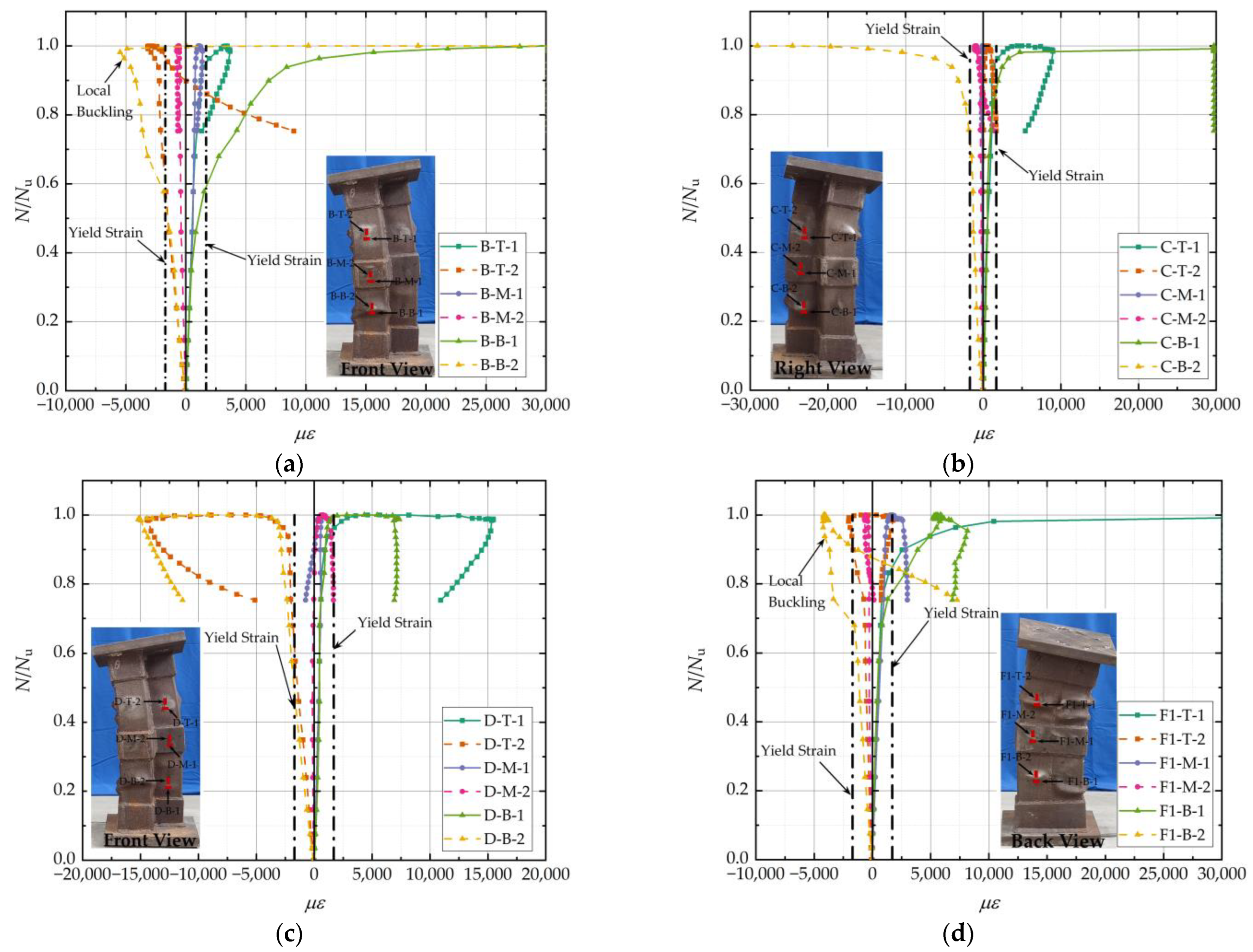
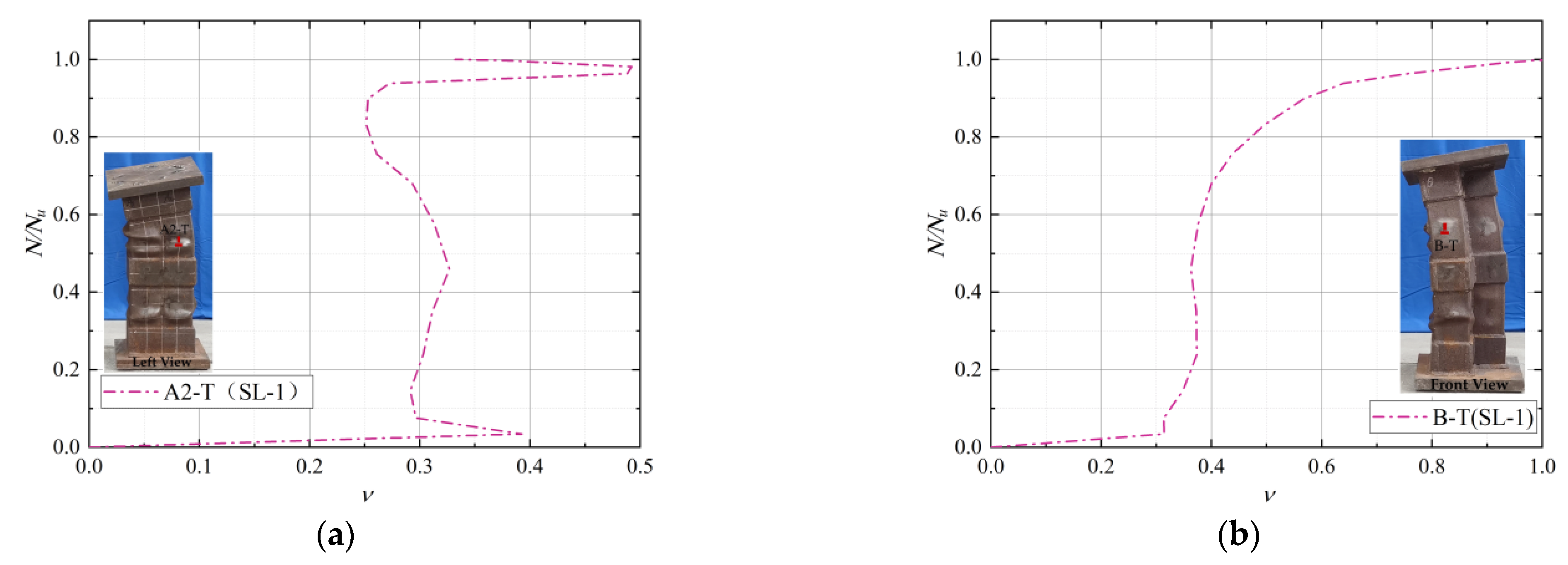
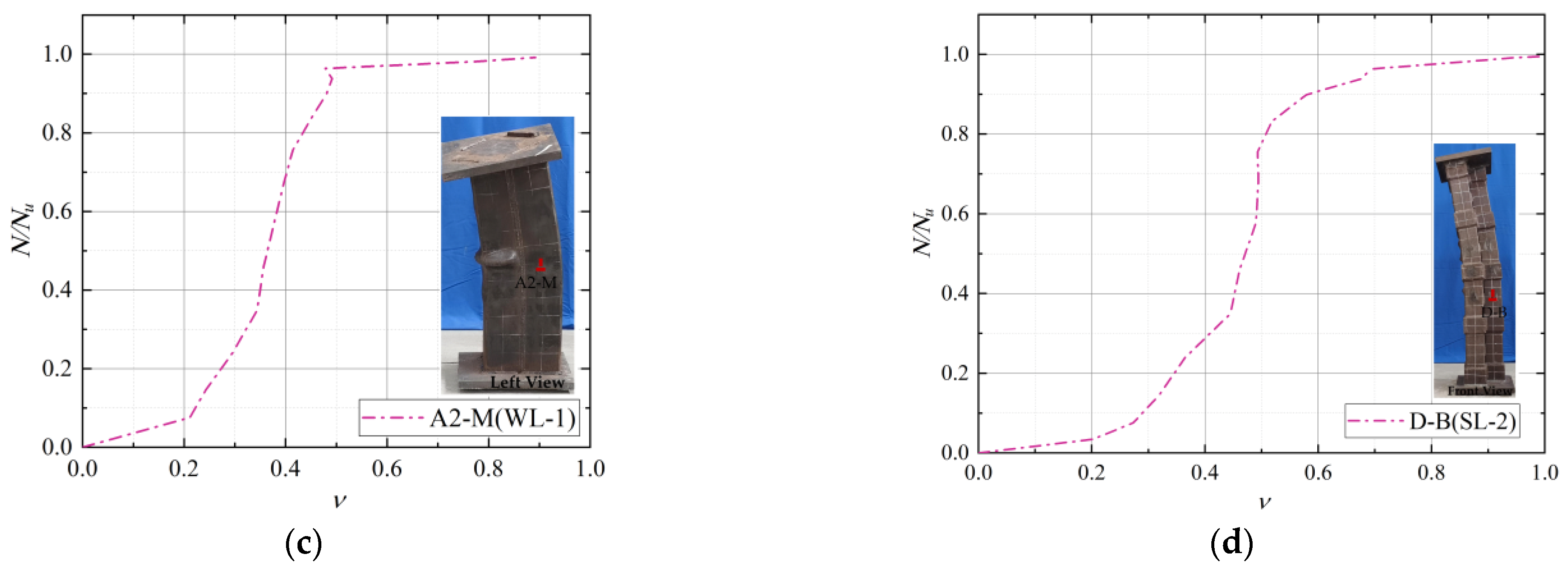
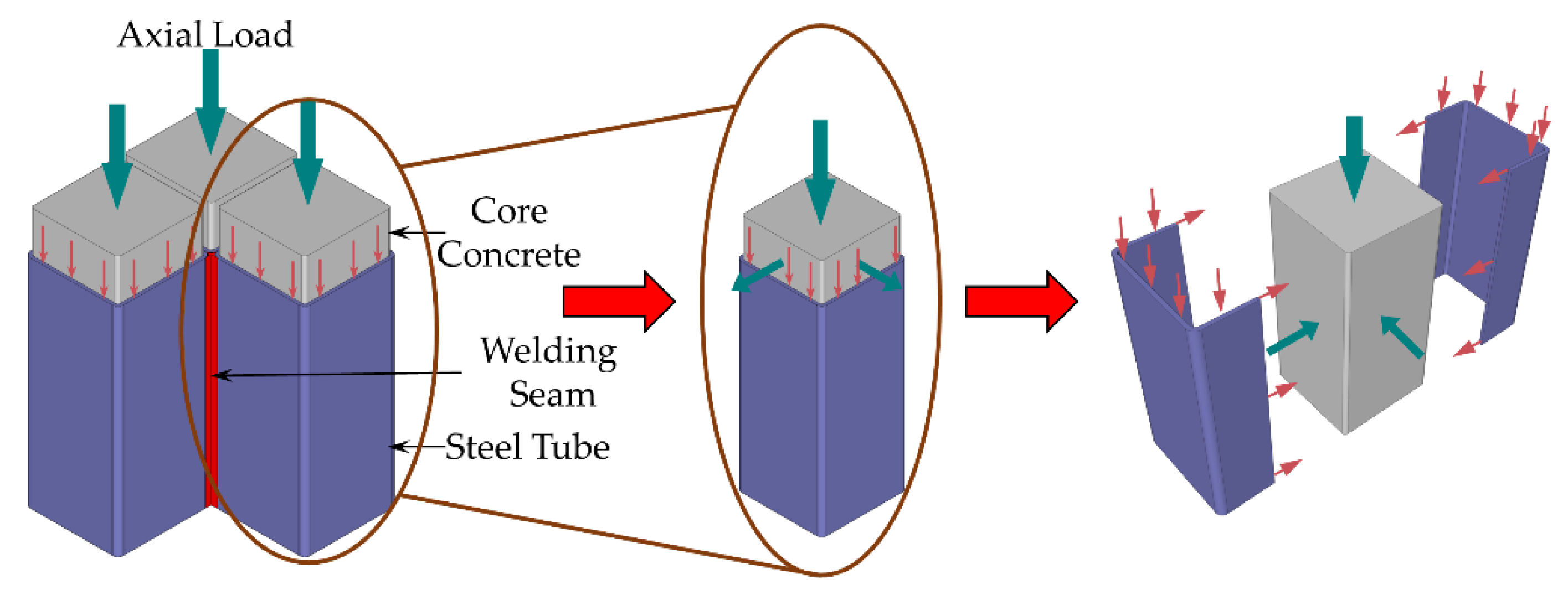

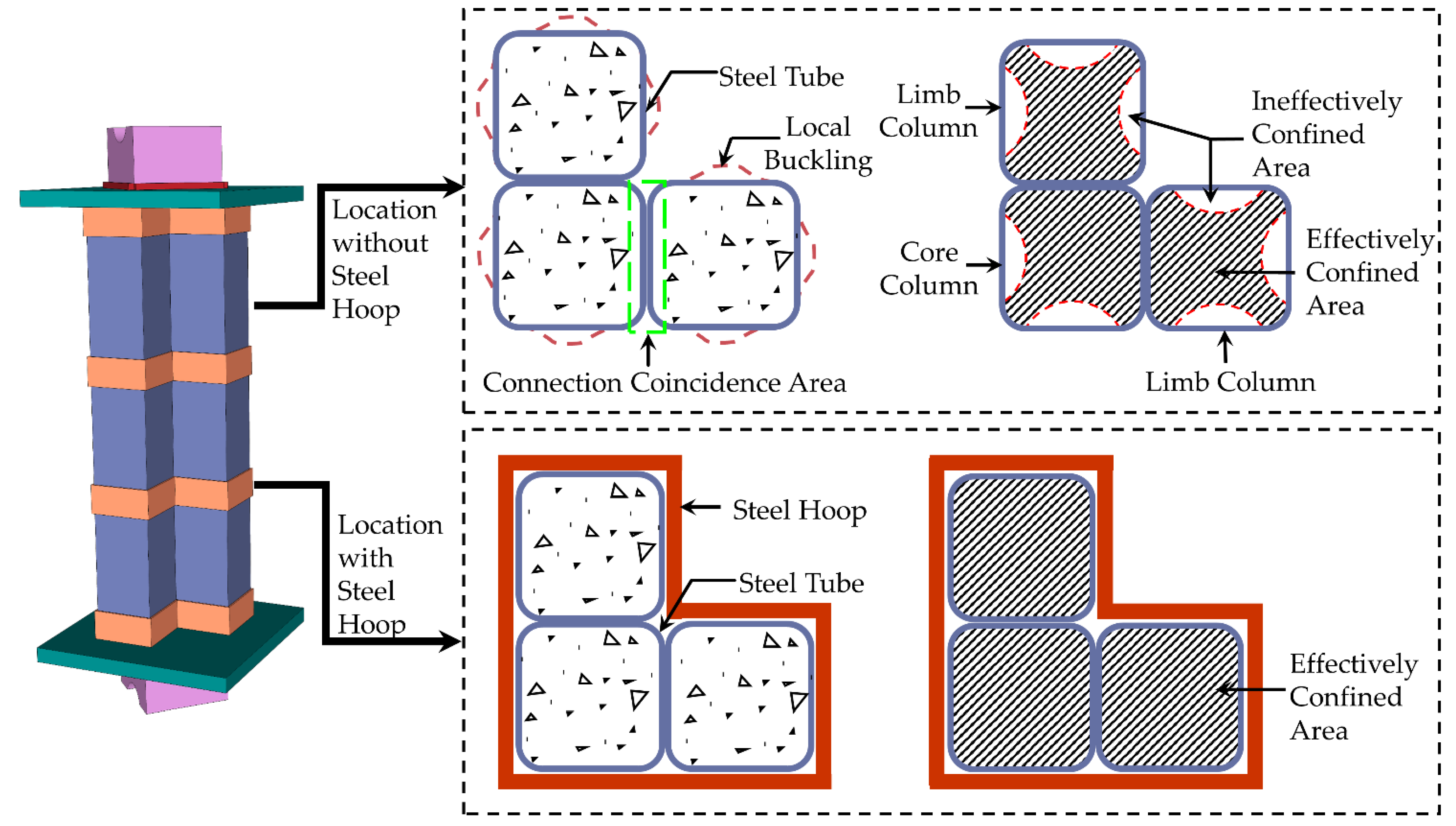




| Specimens | ts (mm) | H (mm) | D (mm) | L (mm) | λ | Steel Grade | Concrete Grade | Np,exp | Type |
|---|---|---|---|---|---|---|---|---|---|
| HL-1 | 4 | 80 | 260 | 600 | 14 | Q355 | C40 | 3140.3 | Hoop |
| HL-2 | 4 | 80 | 280 | 1200 | 27 | Q355 | C40 | 2688.6 | Hoop |
| WL-1 | 4 | - | - | 600 | 14 | Q355 | C40 | 2620.0 | Weld |
| WL-2 | 4 | - | - | 1200 | 27 | Q355 | C40 | 2239.3 | Weld |
| HT-1 | 4 | 80 | 260 | 900 | 16 | Q355 | C40 | 3796.0 | Hoop |
| HT-2 | 4 | 80 | 280 | 1200 | 21 | Q355 | C40 | 3859.0 | Hoop |
| WT-1 | 4 | - | - | 900 | 16 | Q355 | C40 | 3140.7 | Weld |
| WT-2 | 5 | - | - | 1200 | 21 | Q355 | C40 | 3580.7 | Weld |
| Sample | t (mm) | B (mm) | Steel Grade | fy (MPa) | εy (με) | fu (MPa) | E (MPa) | u |
|---|---|---|---|---|---|---|---|---|
| LS4 | 4.0 | 20 | Q355 | 344 | 1699 | 423 | 202,560 | 0.82 |
| LS5 | 5.0 | 20 | Q355 | 390 | 1857 | 488 | 210,055 | 0.81 |
| LS8 | 7.9 | 20 | Q235 | 269 | 1353 | 435 | 199,011 | 0.62 |
| Specimen | Np,exp (kN) | Np,fea/Np,exp | ||
|---|---|---|---|---|
| This Paper | Reference [25] | Reference [26] | ||
| HL-1 | 3140.30 | 0.94 | 0.88 | 0.76 |
| HL-2 | 2688.60 | 1.01 | 0.91 | 0.88 |
| WL-1 | 2620.00 | 0.96 | 0.91 | 0.84 |
| WL-2 | 2239.30 | 1.02 | 1.02 | 0.99 |
| HT-1 | 3796.00 | 0.99 | 0.90 | 0.84 |
| HT-2 | 3859.00 | 0.97 | 0.89 | 0.82 |
| WT-1 | 3140.30 | 1.05 | 1.01 | 0.94 |
| WT-2 | 3580.70 | 1.16 | 1.13 | 1.06 |
| Average | 1.01 | 0.96 | 0.89 | |
| Standard deviation | 0.069 | 0.088 | 0.099 | |
Publisher’s Note: MDPI stays neutral with regard to jurisdictional claims in published maps and institutional affiliations. |
© 2022 by the authors. Licensee MDPI, Basel, Switzerland. This article is an open access article distributed under the terms and conditions of the Creative Commons Attribution (CC BY) license (https://creativecommons.org/licenses/by/4.0/).
Share and Cite
Wang, Z.; Liu, Z.; Zhou, X. Experimental Investigation of Special-Shaped Concrete-Filled Square Steel Tube Composite Columns with Steel Hoops under Axial Loads. Materials 2022, 15, 4179. https://doi.org/10.3390/ma15124179
Wang Z, Liu Z, Zhou X. Experimental Investigation of Special-Shaped Concrete-Filled Square Steel Tube Composite Columns with Steel Hoops under Axial Loads. Materials. 2022; 15(12):4179. https://doi.org/10.3390/ma15124179
Chicago/Turabian StyleWang, Zhen, Zhe Liu, and Xuejun Zhou. 2022. "Experimental Investigation of Special-Shaped Concrete-Filled Square Steel Tube Composite Columns with Steel Hoops under Axial Loads" Materials 15, no. 12: 4179. https://doi.org/10.3390/ma15124179






